New Year Wish For Dog Lovers
All the desires in your heart and
All the hopes in your life blend together,
To give you the most spectacular New Year ever
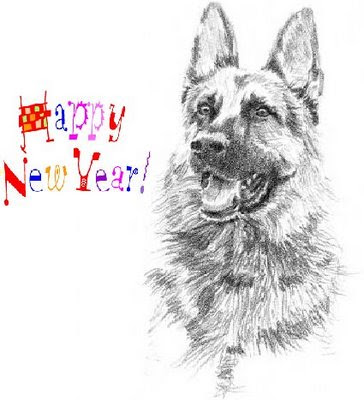 Read more...
Read more...
 Read more...
Read more...
Thanks a million to "istockphoto" for this lovely German shepherd Dog Christmas card. 
Here's a little smile, some words of cheer, a bit of love for dog lovers around the world and their beloved dogs. Here's my Christmas dog lover wishes and best wishes for the coming year.
Let this Christmas wave a magic wand over your world and let the Lord's blessings on you turn all things golden for you.
Cheers
Arindam
Aringsburg
One most real German Shepherd Dog description found by my very personal experiences is that, he is a dog with intense sense of bondage with his own ones. He is a dog that can be called “caninestein” instead of just “canine”. Yes, the degree of intelligence that he possesses, has made him the most talked about breed all over the world. I'm really a happy owner of German Shepherd Dogs, but I can't deny the fact that his intelligence level have fooled me a number of times. Often I've seen him capable of thinking too deeply; even logically of a number of ways to get whatever he wants or to attract my attention. If not trained properly, intelligence of German Shepherds can be nightmare for his owners. Certain funny behaviors that seem to be cute in your GSD puppy today, can throw your life out of gear tomorrow, when he would grow to be a mighty wolf! Here's the importance of proper training. Find a few tips on training GSDs. Read on....
Teach Basic Commands to your German Shepherd
If you're envying to see your friend's well mannered king-size Shepherd, its YOU who's responsible for such discontentment of yourself. It's just a magic of 5 most common words! A well-behaved German shepherd knows to follow the 5 most important basic commands: Come, Sit, Down, Stay and Heel. Teaching these 5 basic actions will make your German Shepherd your most loved companion. This basic training can make life easier for both you and your shepherd. Most importantly, you can keep him and yourself cool and safe in any situation.
Train Your German Shepherd to act on the command “Come”
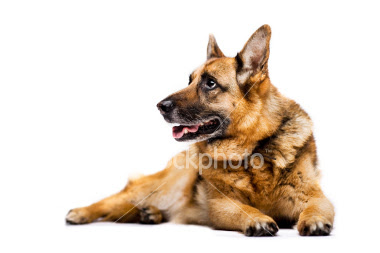
Almost a dozen times in a month I get phone calls from people around my locality and even from far and wide, inquiring about the ways to train up their German Shepherds. Interestingly most of them have already put their German Shepherd on training sessions, but the sadly many of them turn up with loads of complains. Let me tell you that stubbornness and aggression are not typical characteristics of German Shepherd Dogs. These are the consequence of improper training. Believe me, there's no word like “Bad Dog”, the owners, handlers and trainers may be bad and compel their dogs to behave in the way they should not! If your shepherd have are developing bad habits, you are responsible for that – don't blame him! It's due to the lack of socialization and bad training that a dog become what they shouldn't be.
As for my first German Shepherd Dog training tips, Stop Muzzle your GSD Immediately! If a trainer suggests you to muzzle your dog, just move on... look for another good trainer. No point wasting time talking to him regarding dog training. Remember, no reputable dog trainer or canine behaviorist will ask you to muzzle your dog. There are other good ways to control your dog if he is aggressive to other dogs.
 Training German Shepherd Dogs is an art, to be mastered properly before actually you start training a GSD. Here's how to train German Shepherd Dogs.
Training German Shepherd Dogs is an art, to be mastered properly before actually you start training a GSD. Here's how to train German Shepherd Dogs.
Be Gentle While Training a GSD
German Shepherd dog training can be perfectly accomplished by starting at an early age. If you lose your patience and temperament you are an utter flop in this field. Undesirable behaviors have to be dealt with in the most consistent manner. Loving lavishly during the training session won't work; being too harsh to him would be a bad idea either! Things must be dealt with in a gentle manner. Hitting and yelling at him will make your work tougher.
Use His Intelligence
German Shepherd Dog is the world's most intelligent breed after Border Collie and Poodle. He can learn things faster than many of the other dog breeds. This reveals a great opportunity for you, if you are a dog trainer; encash this opportunity! Don't forget to reward him for all positive behaviors with treats and lavish praises. Be consistent in this. You will get to know how smart your German Shepherd puppy is! Remember that German Shepherd Dogs have the inherent quality to distinguish goods from the bads! Your GSD's behavior may be modified at any point of time almost throughout his life.
Early Start Off
Start off training your German Shepherd Dog at an age as early as around 6 months. This will make life easier for both – you and your dog. Letting the problems go unaddressed may be nightmare for you as a GSD owner.
House Training Your German Shepherd Dog
House training German Shepherd Dog is unquestionably a great idea. Once a dog properly housebroken he would never uses the house for his toilet. House breaking your German shepherd puppy can be an easy process or difficult as well depending on the method you follow. Remember it starts on the you bring your GSD puppy home. Right after you bring your puppy home, take him out on a leash to the potty spot as per his choice. Don't carry him to it's potty spot. As soon he reaches the spot, just deliver the command – one single word you would use for him for potty. Be consistent. German Shepherds are very smart to learn things quickly. You have to be a patient and keep an eye on your shepherd all the day. When you see the toilet or potty signs take your GSD puppy out to his potty area. Common signs are circling, floor scratching, ground sniffing and running here and there looking for an apt place for potty.
Chewing Things
All German Shepherd puppies chew on things – sometimes his own body parts. It's a normal behavior – as normal as heartbeats! Just don't be worried. All you need to do is to divert his attention by putting him to play with other puppies and stuff. If he chews you finger... don't let him do that. A single approach to say one word of dissatisfaction (for instance “Uffff or ouch”) in response to the behavior with moderately strict voice can be a good method. But don't forget to get out of the room, leaving him alone for a while. Repeat things as many time as he tries to chew your thumb.
Socializing GSD
Early age socialization is of utmost importance. While an unsocialized German Shepherd may be a nightmare for you, a properly socialized GSD puppy can make the most precious companion. Start of the Socialization session before he is 3 months old. Just try out these few full proved approaches.
One most frequent question that I usually come across is: “How often should I bath my German Shepherd?” Most of the dog sites state that dog doesn't need so frequent bath. True indeed! They do not need frequent bath. But I am sure you don't find this answer quite satisfactory. Well, a lot of things are to be considered to decide how often if you should bath your German Shepherd. Frequent bathing washes off the natural oil of their skin, making it dry and produces dandruffs, which can be one of the major reasons of seborrheic scurf and other dermal infection. Over-bathing your German Shepherd Dog should be avoided to avoid drying out of his skin.The first thing to be considered is how well you maintain him.
Secondly, the country you live and it's climatic condition are of the next prime imporant points to be considered.
Thirdly, season
Fourthly, regular brushing keeps your dog clean.
Fifthly, the place you keep your dog is the last point... but not the least!
A well maintained dog usually doesn't require frequent bath. Maintenance includes everything, starting from feeding right kind of foods to regular cleaning. In fact, to avoid over-bathing proper maintenance is of prime importance. It keeps the most beloved member(s) of your family live a happy and healthy life.
Next most important point is the country you live in. Most people, I have seen, overlook the point. If you are living in tropical country, most likely you may need to bathe your dog more frequently than if you live in colder region. Summers in topical region are really the most dangerous time of the year for breeds like Alsatian dogs. Frequently bathing – sometimes as often as once a week may be required during summer in tropical countries. Summer is the killer season for breeds like German Shepherds in tropical countries. During the flea season, you may need to bathe your German Shepherd Dog more often as a part of a the flea control program.
Routine and regular brushing keeps your shepherd's coat free from mats and tangles, which naturally keeps him clean. Not so frequent washing is required.
Lastly you must keep your kennel clean. It's part of your daily routine.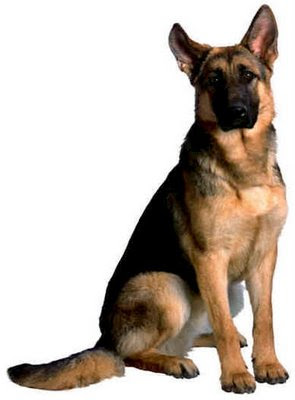
Make sure you use the soap and shampoo specially made for dogs. Why? Because, the body "pH" of a dog is much different from that of human beings. Also remember GSDs' skin "pH" are comparatively higher than most of the other breeds. Picking the right kind of soap and shampoo finds its importance here, when it comes to bathing your shepherd. Make sure water should enter the ears... if this happens, it may end up with serious ear infection in future.
Make sure you rinse him well. Left over shampoo and residual of soap leather will cause skin irritation and infection in future.
Wet coat gets easily tangled. Make sure to dry him well after the bath.
Here's another important tips, you might not have heard before! Between two consecutive baths you can easily manage the odor that can come during this long span of time! All you need to do is to massage some baking soda into the shepherd's coat properly and brush it off well. This will remove the odor. You can repeat this at an interval of 10 – 15 days. This is a temporary deodorizing technique for your dog.
How to use baking soda?
Interestingly, it's quite easy! And you don't need to call a professional groomer for that.
People easily fall in love with German Shepherds without knowing or considering the some of the negetive things about the breed that might turn out to be the owner's nightmare in future. Grooming is something that should be taken into consideration very seriously. And for breeds like German Shepherds, Golden Retrievers and Collies etc. the habbit of not grooming the dog properly can be your major reason worries in future. Well, candidly speaking I'm a bit biased about German Shepherds and find nothing negetive in the breed. It's the owner's irresponsible nature that brings him worries... not the dog. My friends.. take it quite seriously; pick your grooming kit right this moment and be at it! Grooming German Shepherds can be fun, if you love him. And it's not all that a big deal.
German Shepherds... rather call him German Shedders! Yes, this is amongst those breed that shed a lot... and shed all though the year. Why grooming is more essential for a GSD as compared to most of the other breeds? Well, German Sheherd Dogs is a double coated breed, like most of the other dog breeds we know. His coat consists of a wooly type “Under Coat” and longer, straight type, all-season “Guard Coat”. The Guard Coat is the one that guards the “Under Coat”. The Guard Coat in GSDs shed through out the year (normal shedding), while the Under Coat only twice a year (seasonal molting – shedding of dead follicles during winter or summer). If not brushed regularly, your most loved GSD may run a risk of developing mat, which are usually not apperant until they creat clumps of fur, causing dermal infections like rashes, bald spots, hot spots and become stinky. I would suggest to brush your GSD daily at the end of the day, or at least once every alternative day. Let his skin breath properly.
Here's few tips for grooming German Shepherds that I have learned from some of my fellow German Shepherd Dog breeders and have been practicing myself since years:
Rub the coat with the rubber grooming gloves in the direction of the coat once more at the end of the process. You can get an extra shine in his coat. Check out these precious clips brought to you by YouTube to get to know a bit about the Grooming technique and training.
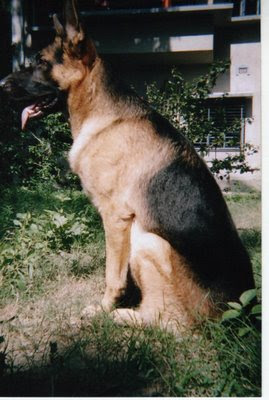
Hey folks... I know I've been a bit too slow and not been posting so frequently. I'm an IT professional and usually remain busy chasing my targets and meetings deadlines, like all my other colleagues and all other peeps in the industry. I hardly get a chance to scoop time out of my busy schedule for maintaining my sites regularly.
Here's something about the Alsatian breed, that you would like to read... I am sure. This would probably be the only post in this site that would have every chance to be always in process. You can waves of interesting facts about German Shepherd Dog breed that any GSD lover would ever want to know.
Have you ever wondered....
1) Which is the world’s first German Shepherd Dog Club and when was it founded?
2) Which was the first GSD to be registered in the stud book of the first GSD Club?
3) How is a Shiloh Shepherd different from a German Shepherd?
4) What was the name of John Kennedy's beloved German Shepherd Dog?
5) what was the name of the first German Shepherd Dog to return back home from the Vietnam War?
6) What rank does this breed acquire in the list of world's 10 most intelligent dog breeds?
Get the answers to all these questions at the official website of About German Shepherd Dog - German Shepherd Dog facts

Key:
A
Achalasia (R) : Dilated oesophagus. Characterized by difficulty in swallowing, Achalasia shows symptoms like chest pain and voluntary or involuntary return of partly digested food from the stomach by vomiting. This is relatively uncommon these days.
Ankylosis (U) : Also spelled as 'Anchylosis'. Inflammation of the joint-ends of the bones - especially in vertebrae in tail or spinal cord - to be fused together, which reduces movement.
B
Bilateral Cataract (D) : Opacification of lens form in both eyes. Bilateral cataract is usually diagnosed after 18 months to 24 months of age.
C
Calcium Gout (S) : Medically known as Calcinosis Circumscripta, Calcium gout are lumps in the skin caused by calcium deposits due to improper absorption of calcium.
Cerebellar Hypoplasia (S) : Cerebellum doesn't mature completely at the birth, which leads to abnormal gait and lack in control. Symptoms usually starts at two months of age or so but sometimes may take 10 to 12 weeks to become apparent. The condition doesn't get worse or better with age.
Chronic Pancreatitis (S) : Inflammation of pancreas accompanied by lack of enzymes secretion, which alters the normal functionality of the digestive system. This gradually leads to weight loss, weakness and ill health, thereby making the dog easily susceptible to diseases.
Cleft Lip and Cleft Palate (N) : Non-closure of bones of upper jaw and roof of mouth, which is a genetic trait, but not always the fact. This usually occurs if the tissues of the lip and/or palate of a fetus do not grow together early in pregnancy. Oral clefting are not commonly found these days.
Corneal Dermoid Cyst (S) : Congenital cyst on eye surface. Corneal dermoid is a congenital Choristoma, which is characterized by heterotopic cutaneous tissue on the surface of the eye, affecting the nictitating membrane, and cornea. Besides GSD, breeds like St. Barnard, Golden Retriever and some short-legged breeds like Dachshund, Welsh Corgis and Basset Hounds are also afflicted to Corneal dermoid cyst.
Cryptorchidism (S) : Undescended testicle(s). Common in GSD. This is a condition present at the birth. The undescended testicle doesn't developed and becomes non-functional, and sometimes turns out to be the major source of problems - especially Cancer, during the matured age.
Cystinuria (R) : It is the metabolic disorder that is characterized by the formation of cystine stones in the kidneys, ureter and bladder. This condition is seen only in males.
D
Degenerative Myelopathy (Chronic Degenerative Radiculomyleopathy - CDRM) (U) : It is an autoimmune disease in which the dog’s own immune system attacks its CNS, leading to loss of myelin (insulation around nerve fibers) and axons (nerve fibers). This degenerative neurologic disease is spinal degeneration or spinal ataxia in older GSDs and some other breeds.
Diabetes Mellitus (R) : Insulin deficiency... low level of blood sugar, which may be noticed at an age as early as 2-6 months. Older animals are more prone to this condition.
Distichiasis (S) : Extra row of eyelashes that grows on the eyelid of the dog and irritates the eye. These eyelashes usually come out from the duct of the meibomian gland that is located at the margin of eyelid. The eyelashes sometimes arises more than one from a duct.
E
Ectasia (R) : Not very much found in GSDs, the condition is called Collie Eye Anomaly or Scleral Ectasia Syndrome or Collie Ectasia Syndrome, this is an optic nerve/retina abnormality in which certain in which certain ocular tissues of the fetus doesn't get properly matured. Its called Collie Eye Anomaly because it was first discovered in Collie breed. the condition also affects some other breeds like Border Collies, Australian Sheepdogs and Shetland Sheepdogs. In Shetland Sheepdogs Ectasia is called 'Sheltie Eye.'
Elbow Dysplasia (D) : Progressive developmental deformity of elbow joints, which is an inherited disease that primarily affects the larger and medium breeds. Other than GSDs the high incidences of occurrences of ED has been noticed in the Golden Retrievers, Rottweilers,
Eosinophilic Colitis (S) : Related to the probles in gastrointestinal tract, this is an inflammation of the colon, or large intestine resulting Chronic bouts of diarrhea.
Eosinophilic Myositis (Masticatory Myositis) (U) : Eosinophilic myositis is a bit too complicated ailment the dog seems to be in pain when trying to open his mouth or chew something. This may be noticed one day all on a sudden or occur gradually. some of the possible reason may be:
Epilepsy (R) : Recurrent seizures. The incidence of occurrences starts between 1-3 years old.
H
Hemophelia A (R) : Blood Clotting disorder, when the blood doesn't clot faster. This happens due to the mutation of factor VIII gene, which leads to deficiency in Factor VIII. Haemophilia increases the risk of severe bleeding from injuries in joints, muscles, digestive tract, brain and other common injuries.
Hip Dysplasia (P) : Although selective breed programs have managed to control the population of the dogs with dysplastic hip, yet it is a polygenic disease - progressive developmental deformity of the hip joints. This can slowly cause crippling and lameness.
I
Intervertebral Disc Disease (S) : The intervertebral discs are the cushion that presents in the space between adjacent spinal vertebrae. These discs are subject to certain degenerative conditions which predispose the vertebral column of the animal to rupture over time. Although suspected to be a genetic disorder, but excessive strain exerted against the spinal cord over time may also result to Intervertebral Disc Disease, leading to gradual worsening of neurologic function, causing pain, weakness and paralysis of limbs.
M
Malabsorption Syndrome (S) : Problem of absorption of one or more nutrients in the food, which causes diarrhoea, abdominal distension, leading to starvation and resulting weight loss.
Monorchism (S) : Monorchism is a condition of having only one testicle descended.
N
Nodular Dermatofibrosis (D) : Inherited Skin Disorder. Dogs afflicted to Nodular Dermatofibrosis will develop lumps on the skin, which can grow from 0.1 to 2 inches in the feet. In severe cases these lumps can ulcerate causing foot deformities and lameness. Nodular Dermatofibrosis is associated with underlying renal cancer or uterine cancer if the female is unspayed.
O
Osteochondritis Dessecans (OCD) (S) : Osteochondritis Dessecans is a disorder of immature long bones.Also spelled as "Dessicans", but I chose to spell "Dissecans" because this is it has been mentioned in Dorland's Medical Dictionary. Suspected to be a genetic ailment it is a growth disorder of long bones. Especially found in the oversized and fast growing progenitors, the growing long bones develops hairline cracks in the in the cartilage of the weight bearing surface, such as shoulder cartilage. The condition worsens to pain and finally lameness.
P
Pannus (S) : This is a chronic inflammation of the cornea, characterized by the invasion of the superficial vessels and pigmented cellsinva into the transparent cornea, leading to opacity... worsening to blindness. Although most affected animals are the ones that are middle-aged, but the disease can develop in young adults too.
Panosteitis (Pano) (S) : Usually seen in oversized and fast growing progenitors, panostitis is Acute Shifting Lameness disease of growing dogs. The afflicted animal suffers from deep bone pain... the reason is unknown. Also called "long bone disease" and "wandering lameness".
Patent ductus arteriosus (P) : This is a polygenic condition, which is aortal development defect in the foetus. The heart murmur will be loud and the animal will be exercise intolerant.
Perianal Fistula (S) : Open draining tracts around or near anus
Peripheral Vestibular Disease (R) : Congenital deafness which is permanent. Defect in the inner ear causing puppies to show unusual behaviours like head tilt, circling behaviour, or a tendency to roll over or fall. The symptoms are noticed by 2 to 4 months of age.
Pituitary Dwarfism (R) : Pituitary Dwarfism is a condition, when the animal becomes abnormally smaller in stature. Although mostly found in almost perfectly proportioned body structure, the condition is sometimes characterized by altered body proportions. While some researchers describe PD to be an autosomal recessive trait, a few believe that it is a polygenic trait.
Progressive Retinal Atrophy (PRA) (R) : Progressive Retinal atrophy retina problem causing gradual but total blindness.
R
Renal Cortical Hypoplasia (S) : Also called Renal Dysplasia, this is a condition when the kidneys are not properly developed (usually undersized)that are not adequately capable of filtering the blood and conserving water and doesn't allow proper flashing off of body toxin.
Scleral Ectasia Syndrome (R) : Not very much found in GSDs, the condition is called Collie Eye Anomaly or Scleral Ectasia Syndrome or Collie Ectasia Syndrome, this is an optic nerve/retina abnormality in which certain in which certain ocular tissues of the foetus doesn't get properly matured. It’s called Collie Eye Anomaly because it was first discovered in Collie breed. The condition also affects some other breeds like Border Collies, Australian Sheepdogs and Shetland Sheepdogs. In Shetland Sheepdogs Ectasia is called 'Sheltie Eye.'
Soft Ears (R) : The ears gets erected properly but with Weak ear musculature. This cause the ears flip as the dog trots or gallop.
Spondylosis Deformans (S) : Spondylosis Deformans is a condition in which bridges are formed along the ventral (bottom) parts of the vertebrae, leading to severe pain. American lines of GSDs have mostly been diagnosed with the condition, however some of the German line GSDs have also found to be afflicted to the disease.
Subaortic Stenosis (U) : Narrowness in the outflow tract of the left ventricle due to an obstruction little below the aortic valve, which causes an obstruction in blood flow from the left ventricle results in left ventricular hypertrophy. This in turn breeds a good chance of developing severe arrhythmia leading to sudden death.
T
Third Eyelid Eversion (Nictitating membrane eversion) (R) : Also called "Cherry Eye", the Third Eyelid Eversion is an ophthalmic condition where an extra growth is developed in the eye lid of the dog and that rolls back to cover the eye. The underside of the growth is a small gland. Surgery is the only resort.
V
Von Willebrand's Disease (vWD) (D) : This is a blood coagulation abnormality predominantly found in GSDs and other breeds like Dobermann, Scottish Terriers etc. It is a type of canine haemophilia which may turn out to be really lethal.
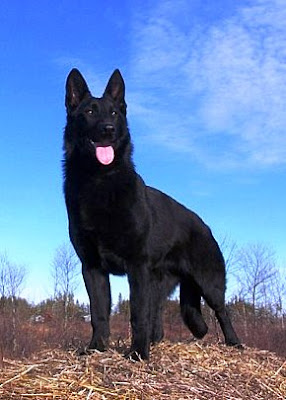 Well, don't be scared... this is one of the toughest chapter. I have been consulting a varried sources since years. Today I just felt like I should write on the colors and patterns in GSDs. Many a times I've been hit by querries, as to whether there is only these colors in GSDs that we usually find in localities and dog shows. Nah.... a lot more are there that are not seen in general dog shows, nor in our localities. Some of the pigments have been declared to be conformation fault; some are really rare genes. But, hey... I'm not a scientist, nor do I understand the magic of gene to the fullest extent. Nor again have I come across all these colors. But I can show you some pics of really awesome pigments and patterns that I've collected while exploring the web randomly. I started gathering info about the colours and patterns in GSDs and related pictures in the year 2003 or so, when my CIZAR (pronounced as 'Scissor') was just a li'l boy.
Well, don't be scared... this is one of the toughest chapter. I have been consulting a varried sources since years. Today I just felt like I should write on the colors and patterns in GSDs. Many a times I've been hit by querries, as to whether there is only these colors in GSDs that we usually find in localities and dog shows. Nah.... a lot more are there that are not seen in general dog shows, nor in our localities. Some of the pigments have been declared to be conformation fault; some are really rare genes. But, hey... I'm not a scientist, nor do I understand the magic of gene to the fullest extent. Nor again have I come across all these colors. But I can show you some pics of really awesome pigments and patterns that I've collected while exploring the web randomly. I started gathering info about the colours and patterns in GSDs and related pictures in the year 2003 or so, when my CIZAR (pronounced as 'Scissor') was just a li'l boy.
When we think of GSDs, the image that reflects in our mind is a robust dog with errect ears, bushy tail, brown almond eyes and royal gesture and kingly gait, with saddle-black or black-tan markings. However, German Shepherd Dogs come in a wide range of colors... saddle-black or black-tan are the ones that are most commonly found. GSDs can be one solid colour – either solid white or solid black. Besides, there are colors like sable with black mask. The patterns include a varried combinations like black & tan, black & red, black & cream, solid black, solid white (conformation disqualification, although a pure gene - not albino), sable (various colorations). GSDs als come in black & silver, liver (rare - conformation fault) and even blue (rare - conformation fault).
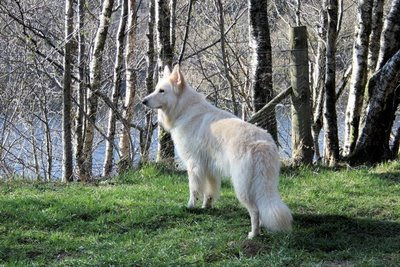 This topic of colors and patterns in German Shepherd Dogs should should not be taken for granted. It is one of the most serious point to be kept in the forefront of mind, especially if you are an aspiring breeder or have already started breeding German Shepherd Dogs. Dr Malcolm B Willis wrote two books "The German Shepherd Dog: A Genetic History" and "Practical Genetics for Dog Breeders", which are still a couple of unparallel books about German Shepherd Dog breed and the genetic configuration thereby. Based on the information in these books here is a brief summary of the patterns and color inheritance in GSDs. Colors in German Shepherd Dogs, as in many other breed as well, are actually controlled by some series of genes.
This topic of colors and patterns in German Shepherd Dogs should should not be taken for granted. It is one of the most serious point to be kept in the forefront of mind, especially if you are an aspiring breeder or have already started breeding German Shepherd Dogs. Dr Malcolm B Willis wrote two books "The German Shepherd Dog: A Genetic History" and "Practical Genetics for Dog Breeders", which are still a couple of unparallel books about German Shepherd Dog breed and the genetic configuration thereby. Based on the information in these books here is a brief summary of the patterns and color inheritance in GSDs. Colors in German Shepherd Dogs, as in many other breed as well, are actually controlled by some series of genes. BLACK SERIES (gene controls the black pigment formation)
WHITE SERIES (The gene that controls 'White' is recessive to all other colors. In order get a white coat color, both parents must carry the white gene - either be white themselves or be carriers of white gene)
COLOR SERIES (This gene controls the intensity of non-black pigments)
DILUTION SERIES (The gene controls how intense the black pigment will be)
MASK SERIES
 Now here's just a note of mine. I have friends and acquaintances who believe that Black (Solid Black) is a separate gene altogether. They mean to say that Solid Black is altogether a distinctive marking pattern that is controlled by an entirely a separate gene. Researchers view it in a bit different way. They say that Solid Black is only the darkest version of the Agouti Series - Agouti marking pattern. Another very common thing that I have noticed is the small white marking in the chest region. I used to think that that was by any chance associated to white gene.
Now here's just a note of mine. I have friends and acquaintances who believe that Black (Solid Black) is a separate gene altogether. They mean to say that Solid Black is altogether a distinctive marking pattern that is controlled by an entirely a separate gene. Researchers view it in a bit different way. They say that Solid Black is only the darkest version of the Agouti Series - Agouti marking pattern. Another very common thing that I have noticed is the small white marking in the chest region. I used to think that that was by any chance associated to white gene.
 s a small litter of three, one of which, I remember, had a small white patch on the chest. I sat back with the pedigree chart again and spent a lot of time over the web and with some of my books and study materials. There wasn't a trace of white gene in the parental lineage of both the Dam and Sire. I was amazed with the magic game of gene! It may be a recessive trait that expresses itself in the absence of a dominant one or may be something really still obscure to the mankind! Stay tuned... I will be talking more about colors and patterns of GSDs and the Brindle one - the one that we do not find these days.
s a small litter of three, one of which, I remember, had a small white patch on the chest. I sat back with the pedigree chart again and spent a lot of time over the web and with some of my books and study materials. There wasn't a trace of white gene in the parental lineage of both the Dam and Sire. I was amazed with the magic game of gene! It may be a recessive trait that expresses itself in the absence of a dominant one or may be something really still obscure to the mankind! Stay tuned... I will be talking more about colors and patterns of GSDs and the Brindle one - the one that we do not find these days.
 I know I have not been posting much here. I am not actually getting enough time to update my personal site. Well, I think I put some really good stuff in Welcome Dog Lovers. Hope, you will be helped. I have been getting mails for not maintaining proper pace here. Okay... here's something that the German Shepherd lovers will really love to read. I think this post is going to help you in ways!
I know I have not been posting much here. I am not actually getting enough time to update my personal site. Well, I think I put some really good stuff in Welcome Dog Lovers. Hope, you will be helped. I have been getting mails for not maintaining proper pace here. Okay... here's something that the German Shepherd lovers will really love to read. I think this post is going to help you in ways!
Many a times I get calls from unknown people looking for a good companion, but confused as to whether they should go for a German Shepherd Dog or not. A lot time I came across people with wrong notions about the breed. Weekends, for me, are like "Attend a Dog Lovers' Call Day". At times I tend to have pity on my cell phone and cordless. Well, I don't mind receiving such calls... I can spend centuries talking about dogs.
People often says "mine is a German Shepherd Dog, not an Alsatian dog". At time they ask is there any difference between GSD and an Alsatian dog? Check out this
Of all existing canine breed in the world today, German Shepherd Dog breed possesses myriad qualities, making it the finest canine specimen in the world. Starting from its intellect and physical appearance to its inherent protective instinct and courageous nature, everything makes the breed a complete canine companion. But the GSDs that we find today are very much different from those of the pasts.
If you are looking for more on how actually German Shepherd Dogs that we see today evaluated, Check out my works on History of German Shepherd Dog Vol I, Vol II, Vol III and Vol IV; and here's a bit more details on History of the breed. Read on...
On April 3rd, 1899 - the same year when Captain Stephanitz formed the Verein für deutsche Schäferhunde (SV) - world's first All-Breed German Dog show was held in Karleruube Rhineland. Captain Stephanitz, and his friend, Arthur Meyer were present in the show. They were looking for a perfect dog to create a really superb herder and fall in love with a dog, strongly built, perfectly healthy, with erect ears, an outgoing and friendly nature. The dog had medium-short coat that was weatherproof. Stephanitz purchased the dog at the spot and this turned out to be the major turning point in the History of German Shepherd Dog.
Hektor Linkshrein was the name of the dog, but later he was renamed into Horand Von Grafrath - the first dog to be registered in the new stud book of the verein. Horand became the foundation dog of the German Shepherd Dog breed. Horand was a from the Thuringian origin and his recessive white genes had been one of the most enhancing factors found in him.
Check out what Captain Stephanitz said about Horand.
Hey... check out what I just found while surfing the net. Thanks to You tube for coming up with such great clips.
Cool German Shepherd Dog Video: Highly Trained Protection Dogs
German Shepherd Dog Information
"Courage without Ferocity and Beauty without Vanity"... said perfect!
German Shepherd Dog Protection Training - Boss
German Shepherd Dog Attack
German Shepherd Dog Seiger Show
Attention dog lovers... German Shepherd puppies for sale! Aringsburg Kennel announces the arrival of a good litter out of highly acclaimed bloodlines at the most competitive price range.
Continuous researches are being in process with the German Shepherd Dog breed! If you're not in continuous touch with what's going on worldwide with this breed, you cannot get track of the evolutionary process of the breed. If you are studying seriously about German Shepherd Dogs you are probably looking for some sort of illustration of German Shepherd Dogs from past till date. Here's something of a kind you probably want to know about German shepherd Dogs. To
To 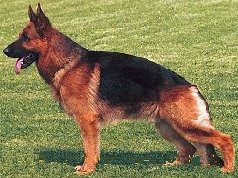
The difference is clearly noticed -- GSD of 1940s to GSD of 2000s, the breed underwent a continuous change.
Notice the German shepherd pictures carefully. You can their's a noticeable difference in the structure of the breed. Look at the 'Top Lines' of the two shepherds. The 'Banana Back', which is also called 'Roach Back' is visible in the recent dog, while the 'Top Lines' was smooth -- called 'Level Back' is noticed in the dog of 1940s.
A couple of other differences worth noticing are:







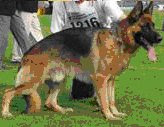 Read more...
Read more...
Reva is 18 months old puppy. She descends from the rich blood line, sired by the son of VA Quirin V Hochmoor (SCHH3 Kkl 1). She is really naughty and hardly sits quietly. It's hard to take her snaps,but somehow I could manage to take one. Check out this. Click on REVA's image and view it enlarged... 
Versatility of Alsatians is beyond question! A well bred German Shepherd Dog is an all round canine companion of his master, although it's true that not all shepherds are equally versatile. If bred properly a German Shepherd puppy will grow up with all the desirable and mandatory instincts that would make it a real royal dog and truly a protective companion of his owner.
Captain Max Von Stephenitz emphasized more on the working ability of the breed than the look. When it comes to the working ability (Schutzhund protection work) of the breed we need to know all about the 5 Basic Instincts of well bred German Shepherd Dogs. These five instincts are genetically inherited by a puppy from it's well bred dam and sire. Selective breeding is hence essential.
Wondering why I'm using the word "Well Bred" so frequently over and over again? Because breeding is that scientific art or artistic science (whatever way you look at it) that will give you a near to perfect dog, if not hundred percent perfect. So a good shepherd is the one that has a good parental lineage and have all or most of the the desirable features -- both structural and behavioral. These German Shepherd instincts are those behavioral aspects that cast a deep impact on the dog's character and behavior, making it a more useful companion. Two of these five basic German Shepherd instincts are known as Critical Instincts.
Here are the 5 Basic Instincts of a "Well Bred" Alsatian.
1. Booty Instinct: Also know as "Prey Instinct", this is one of the two Critical Instincts of a well bred Alsatian dog. This German Shepherd instinct makes the dogs chase moving objects like flies, moths, butterflies, mosquitoes, etc. and seize them. This is one of the most vital instincts for excellent Schutzhund protection work. The Booty/Prey Instinct is mandatory part of a shepherd's character, because it acts as the motivator of striking with speed and power. This critical instinct start to develop as the puppy reaches 6 months of age and eventually becomes prominent as it grows.
Social Aggression is an exclusively a male instinct found in most canine breeds, but seen prominently in GSDs. Though this is a general desirable instinct for all the German Shepherd males, but this instinct remains dormant until the dog faces a threatening situation.
Apart from these 5 Basic Instincts, there are few more general instincts of Alsatians. Stay tuned to read more about the German Shepherd Instincts.
 Well, we talked a lot about the origin and history of German Shepherd Dogs. Here's something very interesting about the breed. Why are German Shepherd Dogs the most versatile breed?
Well, we talked a lot about the origin and history of German Shepherd Dogs. Here's something very interesting about the breed. Why are German Shepherd Dogs the most versatile breed?
If you are really looking for a wonderful, smart , intelligent, protective, decent, courageous, self assertive, sturdy, powerful, royal, loyal and highly trainable working canine companion, German Shepherd Dogs are the right choice for you. The nature of a well bred Alsatian (German Shepherd Dog) is notably different from any other breed of dogs in the world. And it's because of this very different nature (not forgetting the gorgeous look) of the German Shepherd Dogs (GSDs) that the breed rightfully deserves a soft corner in the hearts of zillions of dog lovers across the world.
GSD has earned massive popularity all around the world after the World War II as a perfect working dog breed. To be very candid, no other breed of dog in the world has successfully mastered such a huge range of skills like GSD. This breed is large and powerful enough to tackle a couple of men at a time, protective and courageous enough to protect his master and property and intelligent and responsible enough to to safely control a whole herd of sheep.
True that he cannot outrun a Greyhound, but again it's beyond all controversy that he can show a stand out Turn Of Pace. Moreover a well bred Alsatian can also maintain a steady canter for longer than most of the other breeds of dogs. Besides his awesome intelligence, a well bred Alsatian is an ideal working dog, which is why this breed has really marked a name of itself in varied fields across the globe. Whether as a shepherd dog or rescue dog or a police dog or a guide dog for blind or a guard dog or an attack dog or a war dog or a messenger dog or a sniffer dog or a movie actor, Alsatian dog breed has proved to be the best among all the other dogs in the world. Originally started his career as a shepherd dog breed, Alsatians have underwent a wide range of diversifications insofar the nature of their work is concerned. An incredible number of 48,000 Alsatians took an active role in the Germen regiment during the World War II. This breed has also earned a lot of fame as sentry dog and security dog during the war time and the post war period. The most interesting fact about the breed of German Shepherd Dog is that, this breed was the first canine breed to come in the movie screen. Rin Tin Tin (Rinty) the famous GSD was the world's first canine celebrity who appeared in over 40 hit movies. Within only two years since he started his career as an actor he had been earning 400 pounds per week during 1920s. He had his own car, chauffeur and own bank account.
To begin with Rinty developed a really impressive war record. Owned and trained by Corporal Lee Duncan, Rinty started off his career taking active part in World War I, carrying out important dispatches, sentry and other significant duties for Red Cross. He first appeared as an actor in a movie called "Where The North Begins", directed by Chester Franklin. It was in this film that Rinty set Warner Brothers back on its feet along with a financial set back. The popularity of Rin-Tin-Tin almost became the nightmare of the great stars like Charlie Chaplin and the Gish Sisters. In the year 1925 Rinty was voted as the most popular star of USA.
The saddest part of Rinty's life was that he was insanely busy all through his life and could not enjoy a retirement although he had a remarkable life. Stay Tuned, More about Rin-Tin-Tin to come!
Pictures: Rin Tin Tin, nick name -- Rinty, (often written as Rin-Tin-Tin) Sep. 10th 1918 to Aug 10th 1932.
© Our Blogger Template for Aringsburg's German Shepherd Dogs
Back to TOP